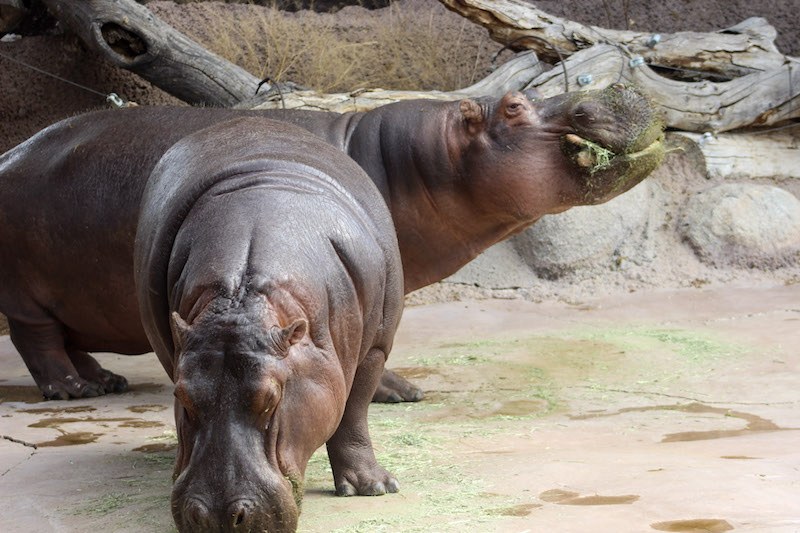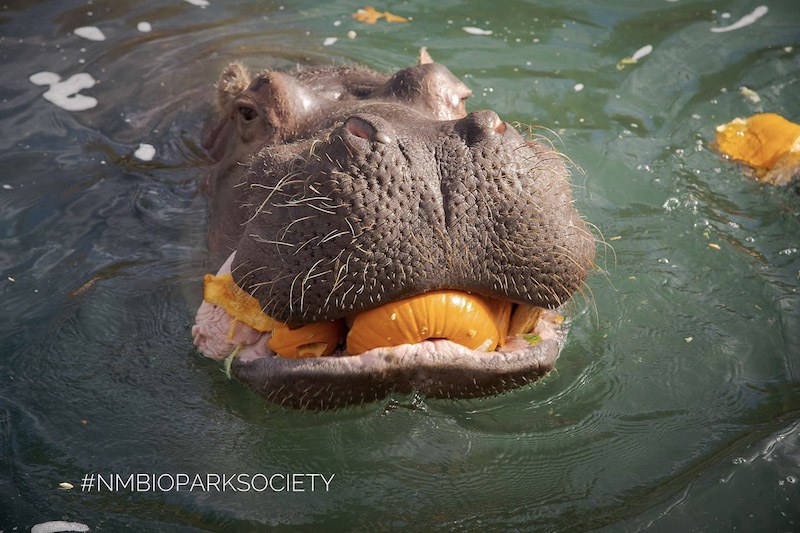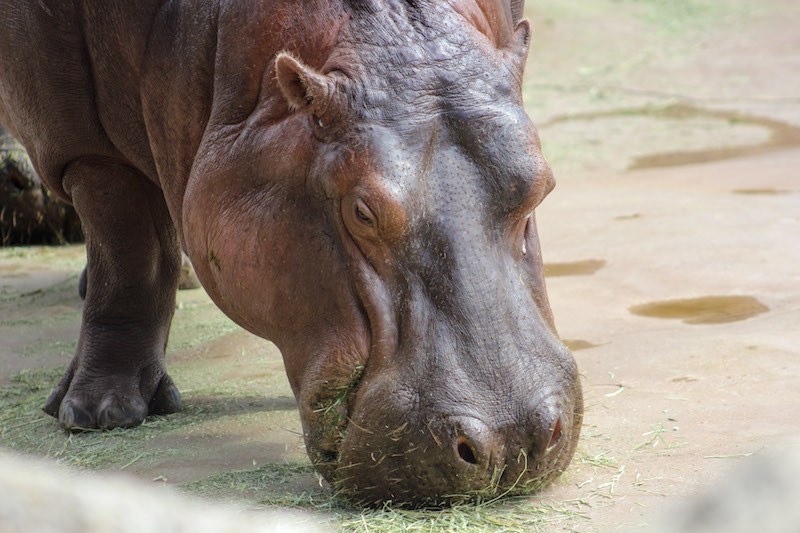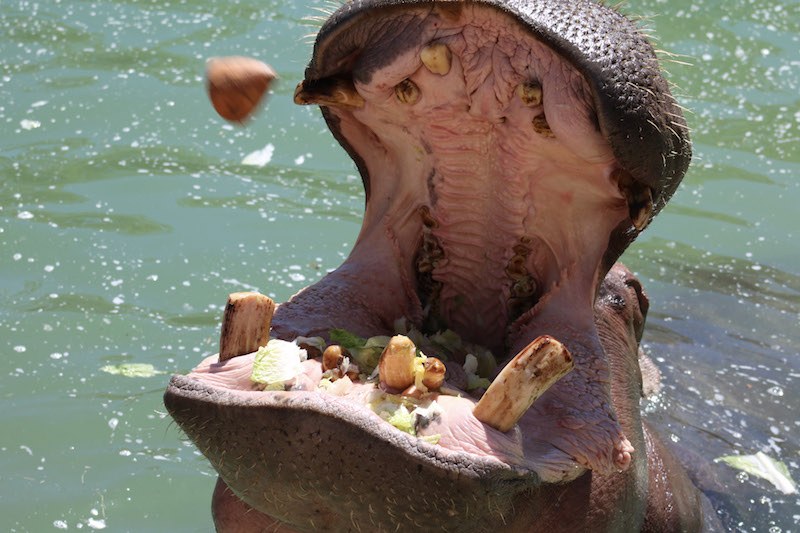Hippos
What do you know about hippopotamuses? Learn about the Albuquerque BioPark’s hippos and what they eat both at the zoo and in the wild.
Hippo Habitat sponsored by the Albuquerque Santa Fe Toyota Dealers
Learning Goal
Learn about how the ABQ BioPark staff cares for hippopotamuses and all the nutrients and exercise they need. Learn about the ABQ BioPark’s role in hippo conservation and the threats these huge herbivores face in the wild.
Introduction to Hippopotamuses

Hippopotamus or “hippo” for short is a huge grass-eating animal that spends the majority of its time in water. Its name originates from the Greek language and means “water horse.” While hippos aren’t closely related to horses they do spend a lot of time in the water—about 16 hours a day in water. Water keeps hippos cool in hot environments and helps protect their skin. Even though they spend the majority of their days in the water, hippos can’t swim. Instead they glide through the water, pushing off of the river bottom and walking submerged. Hippos have some really unique adaptations that make an aquatic life much easier such as special eyelids, and ears and nostrils that can close.
A group of hippos is called a school, bloat or pod. These pods of hippos only sleep for short periods of time off and on throughout the day making them largely nocturnal. They travel and eat mostly during the night. The pods usually consist of 10-30 members and must travel to nearby grasslands to find food; areas around waterholes and rivers usually have no vegetation left because of overgrazing by hippos and other animals. Hippos may travel six miles in one night and walk single-file along paths made by their heavy feet over time. After arriving to the grasses, they use their lips to rip them up and eat continuously for around six hours. They also eat any fallen fruit they find on the ground and have been seen very rarely eating meat. An adult hippo eats about 80 pounds of food each night.
Hippos are the third largest land animal on earth after the elephant and white rhino. Adult females weigh around 3,000 pounds while the males can weigh anywhere from 3,500-10,000 pounds. A pod’s dominant male is usually the largest and heaviest. A newborn baby hippo weighs from 50-110 pounds and starts gaining weight quickly as it grows. A hippo’s huge size, along with its massive incisors, protects it from predators. Even a crocodile is no match for a fully-grown hippopotamus, as their mouths are so large they can easily lift even the largest crocodiles out of the water. Baby hippopotamuses are prey to crocodiles, lions and hyenas, but once a hippopotamus is full-grown their only real predators are humans.
A semi-aquatic life gives hippos a huge advantage because they can submerge in the water and utilize the element of surprise if necessary. They are graceful in water and much better able to protect themselves there. If threatened on land hippos usually run for the water, as this is where they have the advantage. They can run much faster than humans for short bursts; anywhere from 19-30 miles per hour if necessary on-land, and will charge potential threats using their sharp canine and incisor teeth.
BioPark Hippos in 2020

The ABQ BioPark is home to two Nile hippopotamuses: Moe, a large male, and Karen, the resident female. Karen and Moe live inside a habitat with a water pond where they spend most of their time. Guests have the thrill of walking over the hippos on a bridge and also viewing a hippos feeding, where the pair get daily vegetables and play with whatever daily enrichment is in their habitat.
Hippos live roughly 40 years in the wild. They often live 50 years or more in facilities like the ABQ BioPark due to excellent care from zookeepers, special nutrients, mental stimulation and veterinary staff. Karen is now middle-aged at 19 years old and has had two calves. After growing up and getting the best mothering possible from Karen and role-modeling from father Moe, both young hippos moved on as they would naturally in the wild, and now reside at other Association of Zoos and Aquariums (AZA)-accredited facilities. The ABQ BioPark plays an important role in hippopotamus conservation by participating in breeding programs for animals like hippos, as they are labeled as vulnerable on the endangered species scale by the International Union for the Conservation of Nature.
The ABQ BioPark’s hippos eat vegetables and fruits every day. They receive enrichment through different types of food and through special items like pumpkins. They also get an assortment of toys and balls, which encourage natural behaviors like diving, jumping and foraging.
- Watch baby hippo Brynn’s first day with mother Karen as he starts to take his first steps after being born at the BioPark in 2015.
- Watch Karen the hippo with one of the many types of enrichment items/activities the hippos get in order to encourage their natural behaviors.
- Watch the ABQ BioPark’s hippos eat their daily greens and do training for their health and well-being.
Our Actions Matter
It is important to protect hippopotamus habitat in Africa because they already have limited suitable land for their specific needs. They need to utilize what little water they can find during the dry season, and also be relatively close to grassland food resources. They need deep enough water to stay in, greenspaces somewhat nearby and plenty of buffer space from other animals with which they might get into conflict. Their daytime living space can become crowded with 150 hippos or more sharing one pool in the dry season. When humans enter the mix, taking over what once was hippo habitat, it can make life even more difficult for a hippo.
In addition to habitat loss being a major factor in decline of this species, hippo hunting for sport is still a major issue. Tourists from all over the world are attracted to hippo hunts because they are seen as an exciting thrill. Locals are able to make a living by offering excursions such as these. It is important when traveling anywhere to participate in wildlife viewing excursions in their natural habitats and to not participate in big-game hunting of endangered or threatened species.
Hippos are also hunted for their ivory teeth as are rhinos and elephants. Ivory is valuable in the illegal wildlife trade and enforcing regulations around it has proven difficult. You can make a difference by not purchasing ivory and educating others to do the same. Some progress has been made, as there are now rewards for reporting illegal hunting of hippos, but there is much work to be done.
You can help by donating and volunteering your time to the ABQ BioPark and other AZA-accredited facilities. By educating yourself and spreading awareness you can also have a huge impact.
Activity 1: Hungry Hippopotamus

Activity Description
Who is the hungriest hippo? In this spin-off of a classic game we get life-sized and try to collect all of the “grasses” as quickly as we can!
Materials
- One large blanket/sheet or anything else that can represent your swimming hole
- Plastic or tennis balls/rolled up socks (roughly five to 10 per “hippo”)
- Buckets/small plastic laundry hampers (one per “hippo”)
- Timer
Instructions
- Place all the balls/socks a few feet away from your swimming hole.
- Inform students that these are the grasses a hippo eats. Instruct each student/player that they are a hippo and must sit in the swimming hole holding their bucket, which will represent their hippo mouth.
- Count down to the start and set the timer for 10 seconds. After you say, “go!” the hippos may exit the water and collect as much of the socks/balls or “food” as they can with their “mouth” or bucket, but only for 10 seconds. They then have to bring the food back to pond. Repeat this 10-second timer as many times as necessary to bring back all the food.
- Explain to students that in real life hippos can only exit the water for a short amount of time during the day, as they must protect their skin. They usually will only eat at night, and must travel far distances, coming back to water before dawn. The 10 second timer represents one full night.
- Additional option: Tell students to pretend to be asleep during the day while in the pond, and have them “wake-up” at night to forage.
- Ask students what difficulties a hippo might face when trying to get enough food. Is there always food nearby? What predators might attack a baby hippo? How might interactions with humans be a problem?
Activity 2: Huge Mouthed Hippos

Activity Description
How far can you open your mouth? The hippopotamus is considered to have one of the biggest mouths on the planet. In this activity we will use protractors to draw the angles of animal mouths and if you choose, the animals attached.
Materials
- Paper
- Pen/pencil
- Protractor (you can also estimate if you do not have one)
Optional
- Ruler
- Colored pencils/crayons
- Magazines or books of animal images
Instructions
- Use your protractor and writing utensil to measure out and draw the six different angles below. Leave plenty of space around each angle, possibly even using different sheets of paper if you want to eventually include drawings of each.
- 50°
- 70°
- 60°
- 150°
- 100°
- 180°
- Each of the angles is roughly the angle of the mouth of the following six species. Can you guess which angle belongs to which animal? Write down the name of the animal you think the angle corresponds to for all six.
- Crocodile
- Jaguars
- Human
- Pelicans
- Hippo
- Snake
- The correct answers are listed below at the very bottom of the page. Check your answers and then label each angle with the correct name and angle degree.
- Draw the animal attached to each angle if you choose and/or include the teeth on the animal.
- Who has the largest mouth? Brainstorm and write down why you think it is important for the different species to have the mouth sizes that they do. What do they use their mouths for? Eating? Defense?
Added bonus: Look online or in books/magazines for images of animals with their mouths open and calculate the angle on those mouths. Can you find any animals mouths that open wider than a hippopotamus? Who has the smallest mouth? Feel free to also measure and calculate not only the angle of the mouths but also the width, length and height of the mouth and teeth if any can be seen.
Sources
https://www.cabq.gov/culturalservices/biopark/news/baby-hippo-born-at-abq-biopark
https://www.nationalgeographic.com/animals/mammals/h/hippopotamus/
https://www.livescience.com/27339-hippos.html
https://www.hippoworlds.com/hippopotamus-conservation/
https://www.worldwildlife.org/species/hippopotamus
Activity Correct Answers
- Human - 50°
- Crocodile - 70°
- Pelicans – 60°
- Snake - 150°
- Jaguars - 100°
- Hippo - 180°
